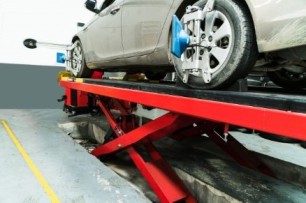General Insurance Blogs, Articles & Updates by - Magma HDI
Have us call you
- RENEW YOUR POLICY
- BUY NEW POLICY

Here is a checklist to follow after the completion of servicing of your bike
Buying a bike takes a lot of thought and planning. Multiple factors influence your purchase. You arrange the funds, and after making a final decision, you pay the money and get a brand new bike. Just like your other possessions, your motorcycle needs optimum care too.
Maintenance of your bike is as essential as your safety while riding it. Whether you frequently use your motorcycle or occasionally, you need to ensure that your vehicle is not damaged. Even a tiny impaired part could cause significant harm to the bike and risk your safety. So as the owner, be careful about its regular maintenance.
All bikes have their periodic servicing cycle. Ensure to get professional servicing for your motorcycle at the authorised service stations. These centres use authentic spare parts recommended by the manufacturer and follow all the procedures to ensure that your bike does not suffer any damages in the long run.
But what happens after your bike is serviced? How can you assure that it has undergone proper servicing? Well, this blog will discuss what you need to keep in mind the next time you get your bike after servicing.
1. Air pressure:
Check the air pressure in the tyres. Unless your bike's tyre is visibly flat, you can't just judge the tyre inflation. Instead, use a tyre pressure gauge to check the correct pressure. Regularly check the motorcycle at different pressures when you ride it.
2. Engine oil:
You should inspect the engine oil after the servicing is completed. Make sure that proper levels are maintained. Look for any leakages. Carbon deposits can thicken the engine oil. Running the bike on dirty oil can damage the engine life in the long run.
3. Brakes:
Examine the brakes very carefully. Your bike's brakes are vulnerable to damage due to their excessive usage on the roads. Make sure that your brakes are not very loose or very tight, which would cause difficulties in applying them when needed.
4. Screeching noise:
If you hear a screeching noise, it could be due to an issue in the front brake pads. Make sure that they are appropriately checked and replaced if needed. Lack of oil could also be one of the reasons for such noises.
5. Spark plug:
Make sure that the spark plug is cleaned. And in case of any damages, ensure that it is replaced. The spark plug is connected to the engine combustion and should undergo regular maintenance. You can keep an eye out for checking the carburettor, air filters, chainset, etc.
Now that we've discussed the checklist you need to follow after completing servicing of your bike, you need to think about how to keep your bike safe from damage during unprecedented situations. The solution is to get your bike insured. And now, you can purchase bike insurance online from the comfort of your home and even get attractive deals with extra benefits. These benefits can reduce your monetary stress and cover your bike's repairing or garage costs.
Click HERE to know more about how you can buy bike insurance online.
Disclaimer: The information provided above is for illustrative purposes only. To get more details, please refer to policy wordings and prospectus before purchasing a policy.

Keeping memories: How to save old photographs properly
For decades, clicking photographs with a film camera was the only way to store memories. Today, we use smartphones to capture and save memories as videos and pictures. However, if you are from the 90s era or before, you must still have hundreds of pictures and photo films locked away in your cupboard or neatly tucked into photo albums.
While tossing out old clothes that we've outgrown may be easy, throwing out photographs is just too difficult. They hold countless memories in a single snapshot that you never want to let go of. You may even put up a few photographs in frames to hang up on the wall or place on your bedside.
However, over the years, you may notice them begin to degrade. Some get brown patches, some turn yellow, and some develop folds and creases around the corner. Therefore, it is essential to remember these tips to preserve old photographs properly.
1. Throw out the old photo albums:
Storing the old photographs in a box or folder does not ensure their protection. Using the usual peel-and-stick photo albums is not the best option for holding your photos. They are usually made of ordinary plastic, glue, and cardboard, which can harm the pictures in the long run. If you want to save them, look for ones free from acid. Avoid albums made with dyes and recycled materials.
2. Do not stick your photographs:
Exposing your photographs to any kind of glue or adhesives can harm their quality. The paper can tear or weaken due to the use of glue. Instead of sticking the photographs in books or albums, look for albums with paper sleeves or acid-free plastic sleeves.
3. Label wisely:
Future generations who inherit the photographs may need the context behind them and labelling them with thorough information can go a long way. However, while most of us might write using a permanent marker or a pen, the ink poses a threat of staining the photographs. Instead, use a pencil and write lightly around the edges to avoid damaging the centre of the image. If you are worried about lead smudging, avoid touching the parts you've written on.
4. Preserve in appropriate locations:
Collections of old photographs are delicate and need to be stored the right way. They need to be boxed in climate-controlled areas of your home that are not too cold, hot, or humid.
Moisture and heat can affect the paper quality and the print of the photograph. Therefore, keeping the albums in paper boxes is better than using plastic boxes. Place these boxes in a closet that is not prone to flooding or intense heat, sunlight, and moisture.
To sum it up, these few measures may help you preserve the quality of your photographs and maintain their shine over the years. To make sure you continue making memorable memories much like the ones you've saved in those photographs, invest in dependable general insurance plans to secure your family.
Click HERE to buy general insurance that best suits your requirements.
Disclaimer: The information provided above is for illustrative purposes only. To get more details, please refer to policy wordings and prospectus before purchasing a policy.

Here's everything you need to know about car insurance for your electric vehicle
In recent times, Indians have increasingly begun opting for electric vehicles. The reasons include saving on fuels and interest in ecologically beneficial features. When deciding if an EV is the best option for you, examine how an electric vehicle varies from a car with a combustible engine. One of these distinctions is insurance, and you must understand how an electric car's insurance in India works.
So, to help you with just that, we've discussed everything about electric car insurance in this post.
The importance of Electric Car Insurance.
1. Mandatory by Indian law:
The Motor Vehicle Act 1988 of India covers all vehicle legislation. According to the act, all cars (including EVs) are required to carry vehicle insurance to operate legally on public highways.
2. Damage protection:
Appropriate protection is essential to prevent or control damages caused due to accidents. Anyone who has had any experience with automobile repairs knows about the expenses involved, especially in the case of electric vehicles. Thus, whether the damage to your automobile is due to your fault or someone else's, a car insurance policy will cover the repairs without putting pressure on your pockets.
3. Third-party liability:
In the event of an accident claim involving third parties, you will be required to pay for any damage incurred out of your pocket. However, you won't have to worry about these ramifications with third-party liability insurance. Under your car insurance cover, your insurance company handles and compensates for any loss or damage done to third parties.
4. Personal accident covers:
Personal accident cover is also mandated as per Indian law. It protects you against uncertainties like accidental death, injuries etc. Remember, it does not come with the car insurance plan but needs to be purchased separately as an add-on feature.
Please note, there are no separate insurance plans for Electric Vehicles (as of yet). The general insurance sector in India has yet to provide specialised coverage for EVs. As of now, consumers must choose from current car insurance policies designed for vehicles with combustible engines.
Also, the IRDAI has recently ordered that insurers should promote electric car insurance policies. This means that India's third-party insurance coverage for electric vehicle cars will cost lower than traditional petrol/diesel vehicles.
What is covered under Electric vehicle insurance?
• Personal accident coverage
• Third-party insurance coverage
• Car theft
• Road accidents
• Damage resulting from fire
• Repairs and replacements of parts
• Damage resulting from a natural calamity
What is not covered under electric vehicle insurance?
• Claims after drinking and driving
• Claims if the driver is found without a driving license
• Higher damage caused due to intentional negligence
• Lapsed insurance claims
To conclude, whether you own an electric car or a traditional one. Having car insurance is mandatory and acts as your financial safety cushion. Like all your expensive belongings, protect your electric automobile against damages.
Car insurance guarantees that your vehicle stays in good condition for a long time and helps you avoid monetary stress. It also pays for expenditures incurred as a result of third-party harm. Furthermore, the IRDAI has decreased third-party insurance prices for electric vehicles by 15%. So save your EV from potential damage like it protects the environment.
Click HERE to get the best deals on car insurance.
Disclaimer: The information provided above is for illustrative purposes only. To get more details, please refer to policy wordings and prospectus before purchasing a policy.

Know more about the wheel alignment of your car and how to check it by yourself
To be a vehicle owner entails a variety of duties. To get the most out of your automobile, you must frequently care for and repair it. If sufficient care is not performed, not only will your vehicle's quality suffer, but it may also cause an accident. Having your vehicle's tyres aligned regularly is one of the most important things you need to ensure tyres last longer.
Many individuals believe that alignment should be left to specialists. While this is true in many ways, some alignment specifications are simple enough to check on your own, and wheel alignment is one of them. This may be useful after upgrading steering or suspension parts so that the car isn't out of alignment during the journey to the shop, or it can at the very least offer a better knowledge of the process.
Following are a few ways you can check your car's wheel alignment by yourself.
1. Caster:
Most vehicles are constructed with a mild downward caster. Your caster angle contributes to the equilibrium of driving, balance, and turning. A high caster causes the steering axis to lean toward the driver. On the other hand, a low caster indicates that your vehicle's steering axis is tilted away from the driver.
To measure the caster angle yourself, you need to park the vehicle on a flat surface and place both wheels on the turntables. Next, install the bubble gauge on the hub. Then turn the tyre 20 degrees inwards and level the gauge. Using the adjustment knob, set the caster reading as zero. Now, move the tyre 20 degrees outwards to get the caster reading.
2. Camber:
Camber is the degree of tyre lean of a car measured in degrees. Negative camber takes place when the top of the tyre tilts inwards. Whereas positive camber occurs when the top of the tyre tilts outwards.
Most contemporary automobiles feature a somewhat negative camber to increase stability and control. Camber misalignment may be caused by worn bearing, ball joints, and other wheel suspension systems. Excessive inward or outward skew indicates poor alignment and must be corrected.
3. Toe-in:
Toe alignment, as opposed to camber alignment, is the degree to which your tyres spin inward or outward as seen from up top. Depending on the vehicle, typical toe-in standards range from one-thirty-second to one-eighth-inch. Toe-in alignment occurs when your automobile's tyres are inclined in the same direction. Toe alignments are done at the last after caster and camber are done.
As a vehicle owner, you must recognise the signs of misaligned wheels. Take a moment to check your vehicle's wheel alignment regularly. It can add to the life of your car's tyres and improve the handling. Even if you decide to get the vehicle aligned in a garage, you will better understand the issue and information.
As needed, trained and experienced vehicle experts will be able to align your wheels. However, to sustain the absolute protection of your vehicle, yourself, and anyone around you, it is advisable to opt for insurance. If you have just purchased a new car, always remember to buy new car insurance to safeguard your vehicle.
Click HERE to buy new car insurance.
Disclaimer: The information provided above is for illustrative purposes only. To get more details, please refer to policy wordings and prospectus before purchasing a policy.


